Holmes Institute HI5017: Managerial Accounting Report Analysis
VerifiedAdded on 2022/12/01
|10
|3755
|152
Report
AI Summary
This report examines managerial accounting techniques and their application in business decision-making, drawing on two journal articles. It explores the importance of management accounting, highlighting methods such as Activity-Based Costing (ABC) and the Balance Scorecard (BSC), and benchmarking. The report analyzes how companies can benefit from these techniques, emphasizing their relevance in achieving business goals. The report compares two journal articles, one focusing on the evolution of management accounting and the other on the use of the BSC approach. It also discusses the practical use of management accounting systems, their relevance to real-life companies, and their role in aiding managers' decision-making. The report provides insights into how these tools can be used to improve product quality, enhance efficiency, and gain a competitive edge. The analysis includes a case study of a company that implements the balanced scorecard, demonstrating how these management accounting techniques can be used to improve business performance.
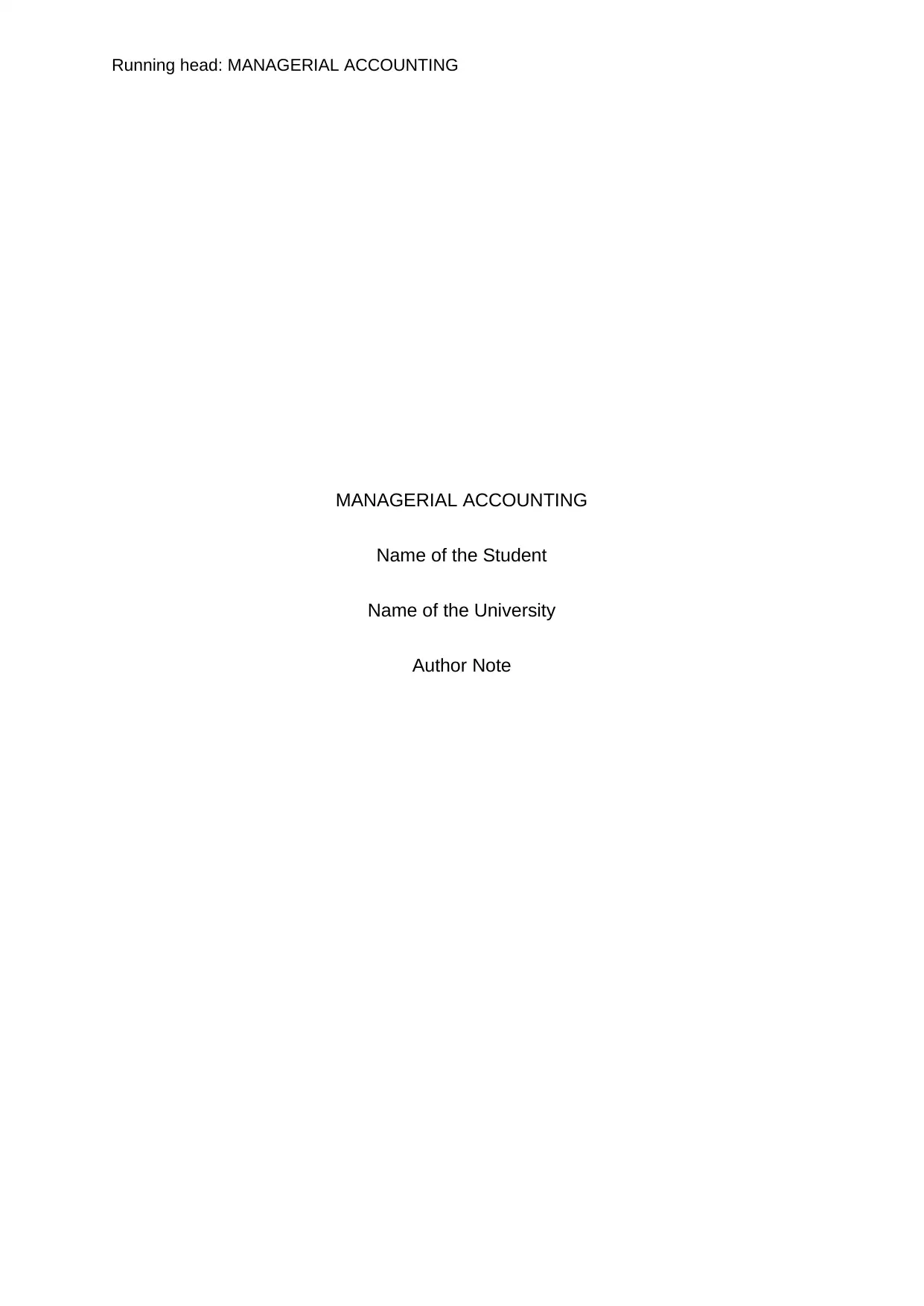
Running head: MANAGERIAL ACCOUNTING
MANAGERIAL ACCOUNTING
Name of the Student
Name of the University
Author Note
MANAGERIAL ACCOUNTING
Name of the Student
Name of the University
Author Note
Paraphrase This Document
Need a fresh take? Get an instant paraphrase of this document with our AI Paraphraser
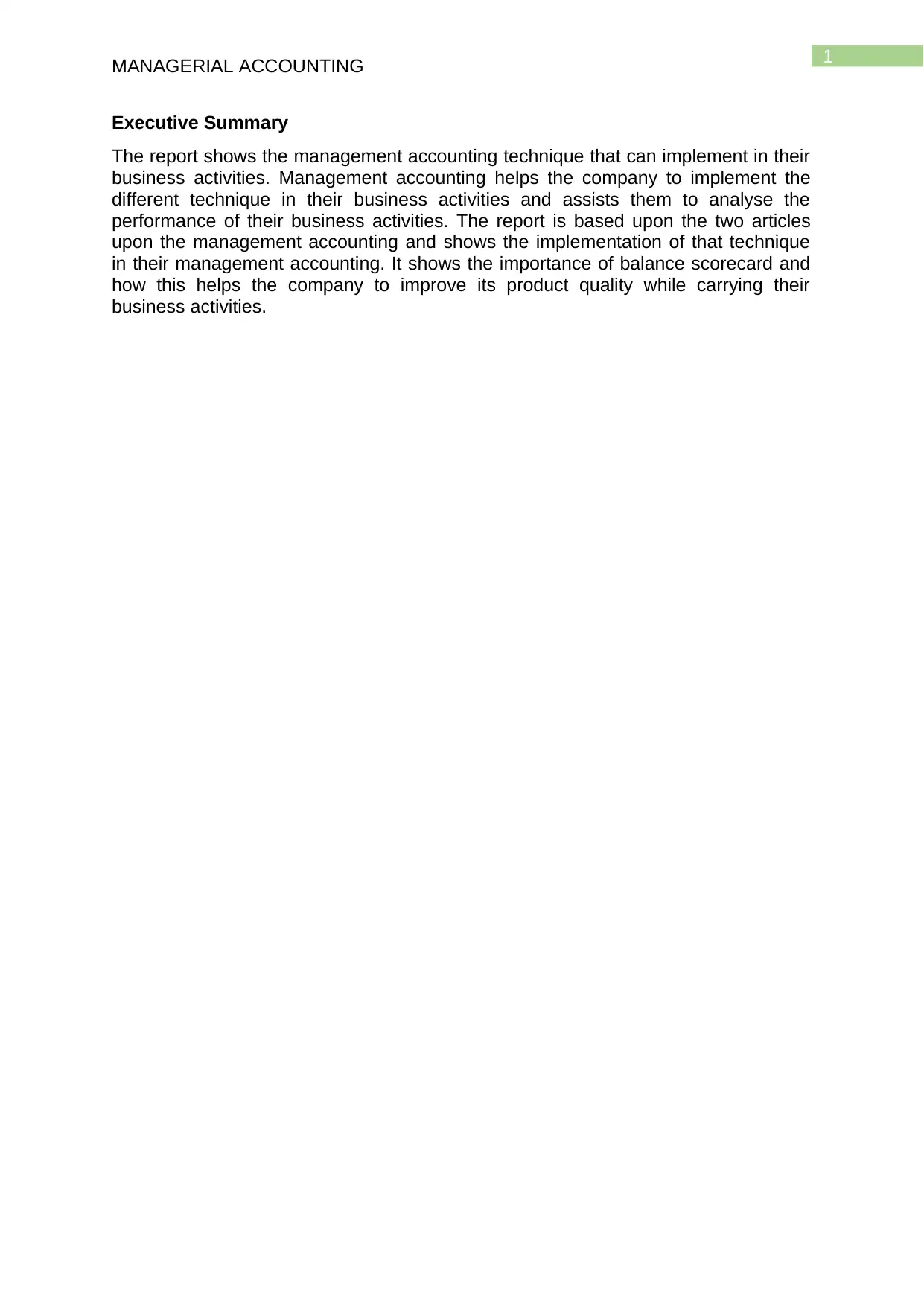
1
MANAGERIAL ACCOUNTING
Executive Summary
The report shows the management accounting technique that can implement in their
business activities. Management accounting helps the company to implement the
different technique in their business activities and assists them to analyse the
performance of their business activities. The report is based upon the two articles
upon the management accounting and shows the implementation of that technique
in their management accounting. It shows the importance of balance scorecard and
how this helps the company to improve its product quality while carrying their
business activities.
MANAGERIAL ACCOUNTING
Executive Summary
The report shows the management accounting technique that can implement in their
business activities. Management accounting helps the company to implement the
different technique in their business activities and assists them to analyse the
performance of their business activities. The report is based upon the two articles
upon the management accounting and shows the implementation of that technique
in their management accounting. It shows the importance of balance scorecard and
how this helps the company to improve its product quality while carrying their
business activities.
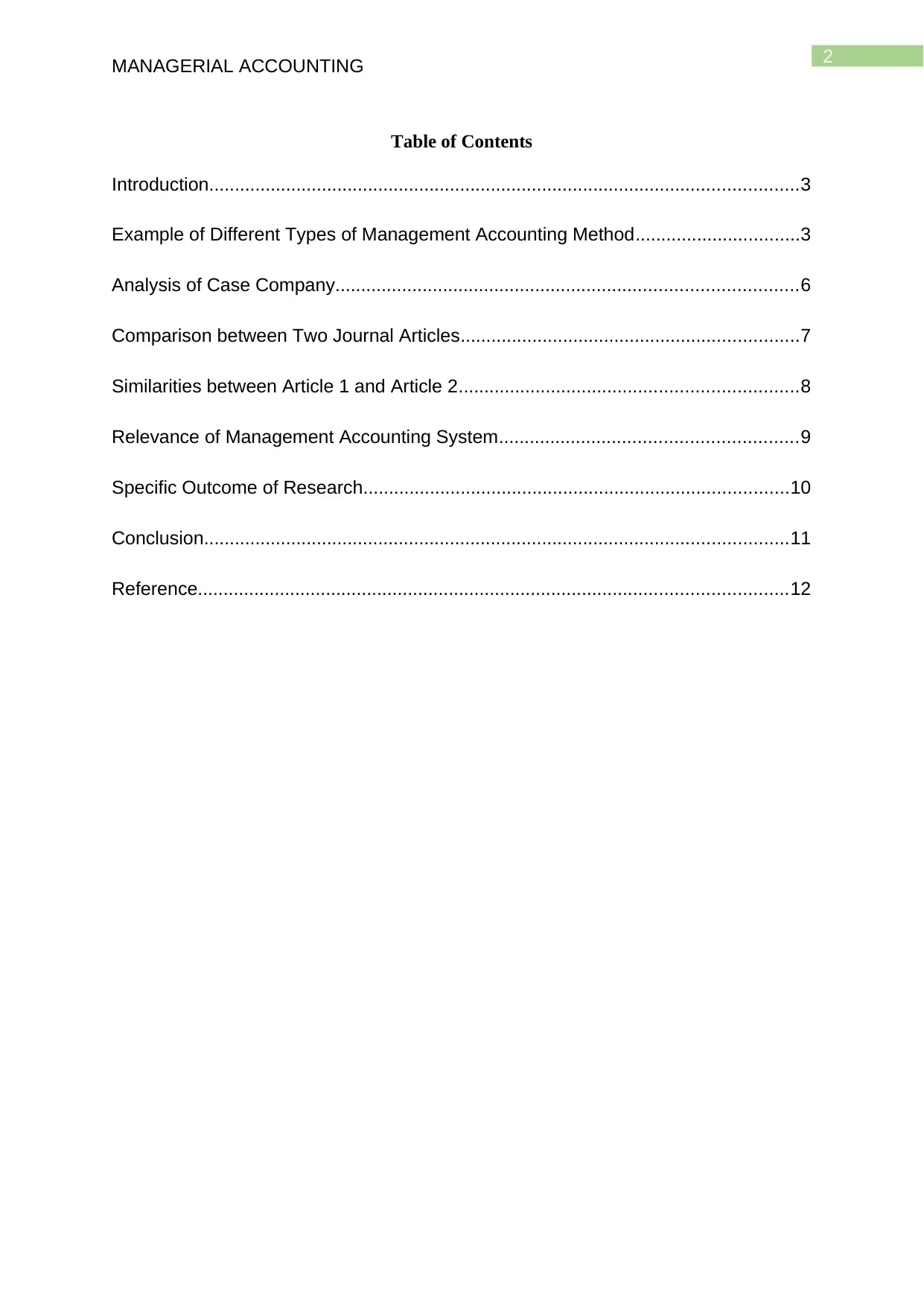
2
MANAGERIAL ACCOUNTING
Table of Contents
Introduction...................................................................................................................3
Example of Different Types of Management Accounting Method................................3
Analysis of Case Company..........................................................................................6
Comparison between Two Journal Articles..................................................................7
Similarities between Article 1 and Article 2..................................................................8
Relevance of Management Accounting System..........................................................9
Specific Outcome of Research...................................................................................10
Conclusion..................................................................................................................11
Reference...................................................................................................................12
MANAGERIAL ACCOUNTING
Table of Contents
Introduction...................................................................................................................3
Example of Different Types of Management Accounting Method................................3
Analysis of Case Company..........................................................................................6
Comparison between Two Journal Articles..................................................................7
Similarities between Article 1 and Article 2..................................................................8
Relevance of Management Accounting System..........................................................9
Specific Outcome of Research...................................................................................10
Conclusion..................................................................................................................11
Reference...................................................................................................................12
⊘ This is a preview!⊘
Do you want full access?
Subscribe today to unlock all pages.

Trusted by 1+ million students worldwide
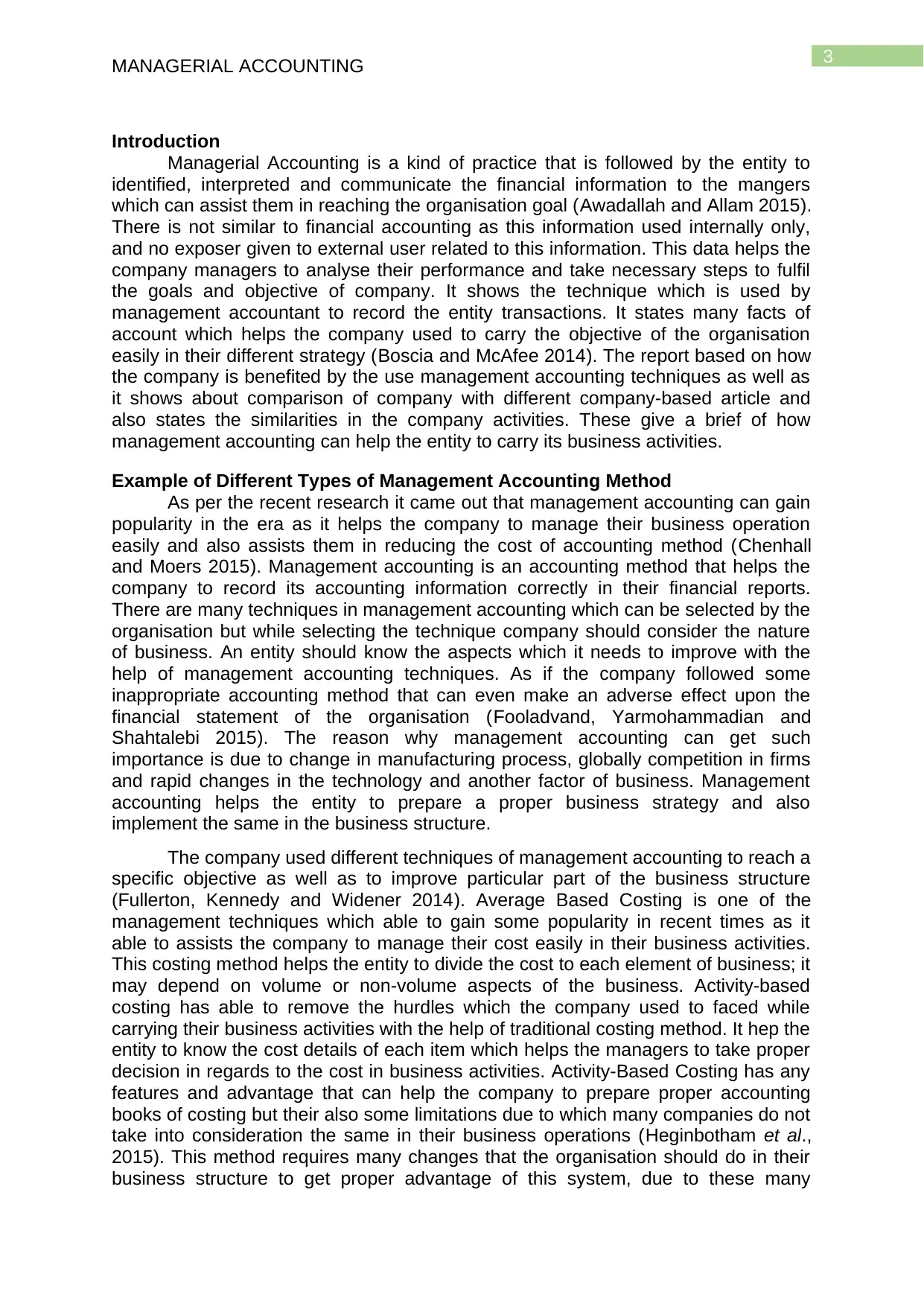
3
MANAGERIAL ACCOUNTING
Introduction
Managerial Accounting is a kind of practice that is followed by the entity to
identified, interpreted and communicate the financial information to the mangers
which can assist them in reaching the organisation goal (Awadallah and Allam 2015).
There is not similar to financial accounting as this information used internally only,
and no exposer given to external user related to this information. This data helps the
company managers to analyse their performance and take necessary steps to fulfil
the goals and objective of company. It shows the technique which is used by
management accountant to record the entity transactions. It states many facts of
account which helps the company used to carry the objective of the organisation
easily in their different strategy (Boscia and McAfee 2014). The report based on how
the company is benefited by the use management accounting techniques as well as
it shows about comparison of company with different company-based article and
also states the similarities in the company activities. These give a brief of how
management accounting can help the entity to carry its business activities.
Example of Different Types of Management Accounting Method
As per the recent research it came out that management accounting can gain
popularity in the era as it helps the company to manage their business operation
easily and also assists them in reducing the cost of accounting method (Chenhall
and Moers 2015). Management accounting is an accounting method that helps the
company to record its accounting information correctly in their financial reports.
There are many techniques in management accounting which can be selected by the
organisation but while selecting the technique company should consider the nature
of business. An entity should know the aspects which it needs to improve with the
help of management accounting techniques. As if the company followed some
inappropriate accounting method that can even make an adverse effect upon the
financial statement of the organisation (Fooladvand, Yarmohammadian and
Shahtalebi 2015). The reason why management accounting can get such
importance is due to change in manufacturing process, globally competition in firms
and rapid changes in the technology and another factor of business. Management
accounting helps the entity to prepare a proper business strategy and also
implement the same in the business structure.
The company used different techniques of management accounting to reach a
specific objective as well as to improve particular part of the business structure
(Fullerton, Kennedy and Widener 2014). Average Based Costing is one of the
management techniques which able to gain some popularity in recent times as it
able to assists the company to manage their cost easily in their business activities.
This costing method helps the entity to divide the cost to each element of business; it
may depend on volume or non-volume aspects of the business. Activity-based
costing has able to remove the hurdles which the company used to faced while
carrying their business activities with the help of traditional costing method. It hep the
entity to know the cost details of each item which helps the managers to take proper
decision in regards to the cost in business activities. Activity-Based Costing has any
features and advantage that can help the company to prepare proper accounting
books of costing but their also some limitations due to which many companies do not
take into consideration the same in their business operations (Heginbotham et al.,
2015). This method requires many changes that the organisation should do in their
business structure to get proper advantage of this system, due to these many
MANAGERIAL ACCOUNTING
Introduction
Managerial Accounting is a kind of practice that is followed by the entity to
identified, interpreted and communicate the financial information to the mangers
which can assist them in reaching the organisation goal (Awadallah and Allam 2015).
There is not similar to financial accounting as this information used internally only,
and no exposer given to external user related to this information. This data helps the
company managers to analyse their performance and take necessary steps to fulfil
the goals and objective of company. It shows the technique which is used by
management accountant to record the entity transactions. It states many facts of
account which helps the company used to carry the objective of the organisation
easily in their different strategy (Boscia and McAfee 2014). The report based on how
the company is benefited by the use management accounting techniques as well as
it shows about comparison of company with different company-based article and
also states the similarities in the company activities. These give a brief of how
management accounting can help the entity to carry its business activities.
Example of Different Types of Management Accounting Method
As per the recent research it came out that management accounting can gain
popularity in the era as it helps the company to manage their business operation
easily and also assists them in reducing the cost of accounting method (Chenhall
and Moers 2015). Management accounting is an accounting method that helps the
company to record its accounting information correctly in their financial reports.
There are many techniques in management accounting which can be selected by the
organisation but while selecting the technique company should consider the nature
of business. An entity should know the aspects which it needs to improve with the
help of management accounting techniques. As if the company followed some
inappropriate accounting method that can even make an adverse effect upon the
financial statement of the organisation (Fooladvand, Yarmohammadian and
Shahtalebi 2015). The reason why management accounting can get such
importance is due to change in manufacturing process, globally competition in firms
and rapid changes in the technology and another factor of business. Management
accounting helps the entity to prepare a proper business strategy and also
implement the same in the business structure.
The company used different techniques of management accounting to reach a
specific objective as well as to improve particular part of the business structure
(Fullerton, Kennedy and Widener 2014). Average Based Costing is one of the
management techniques which able to gain some popularity in recent times as it
able to assists the company to manage their cost easily in their business activities.
This costing method helps the entity to divide the cost to each element of business; it
may depend on volume or non-volume aspects of the business. Activity-based
costing has able to remove the hurdles which the company used to faced while
carrying their business activities with the help of traditional costing method. It hep the
entity to know the cost details of each item which helps the managers to take proper
decision in regards to the cost in business activities. Activity-Based Costing has any
features and advantage that can help the company to prepare proper accounting
books of costing but their also some limitations due to which many companies do not
take into consideration the same in their business operations (Heginbotham et al.,
2015). This method requires many changes that the organisation should do in their
business structure to get proper advantage of this system, due to these many
Paraphrase This Document
Need a fresh take? Get an instant paraphrase of this document with our AI Paraphraser
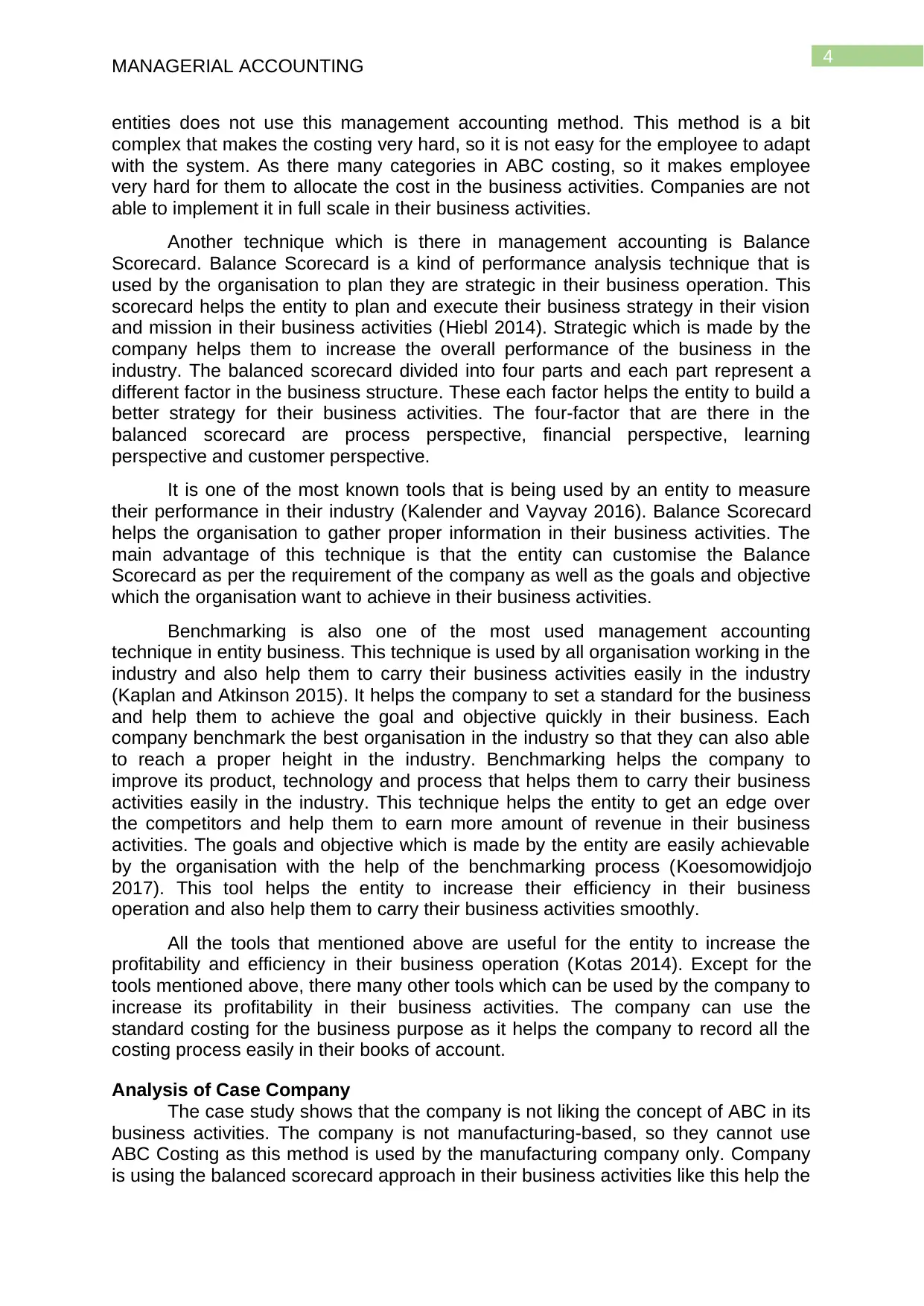
4
MANAGERIAL ACCOUNTING
entities does not use this management accounting method. This method is a bit
complex that makes the costing very hard, so it is not easy for the employee to adapt
with the system. As there many categories in ABC costing, so it makes employee
very hard for them to allocate the cost in the business activities. Companies are not
able to implement it in full scale in their business activities.
Another technique which is there in management accounting is Balance
Scorecard. Balance Scorecard is a kind of performance analysis technique that is
used by the organisation to plan they are strategic in their business operation. This
scorecard helps the entity to plan and execute their business strategy in their vision
and mission in their business activities (Hiebl 2014). Strategic which is made by the
company helps them to increase the overall performance of the business in the
industry. The balanced scorecard divided into four parts and each part represent a
different factor in the business structure. These each factor helps the entity to build a
better strategy for their business activities. The four-factor that are there in the
balanced scorecard are process perspective, financial perspective, learning
perspective and customer perspective.
It is one of the most known tools that is being used by an entity to measure
their performance in their industry (Kalender and Vayvay 2016). Balance Scorecard
helps the organisation to gather proper information in their business activities. The
main advantage of this technique is that the entity can customise the Balance
Scorecard as per the requirement of the company as well as the goals and objective
which the organisation want to achieve in their business activities.
Benchmarking is also one of the most used management accounting
technique in entity business. This technique is used by all organisation working in the
industry and also help them to carry their business activities easily in the industry
(Kaplan and Atkinson 2015). It helps the company to set a standard for the business
and help them to achieve the goal and objective quickly in their business. Each
company benchmark the best organisation in the industry so that they can also able
to reach a proper height in the industry. Benchmarking helps the company to
improve its product, technology and process that helps them to carry their business
activities easily in the industry. This technique helps the entity to get an edge over
the competitors and help them to earn more amount of revenue in their business
activities. The goals and objective which is made by the entity are easily achievable
by the organisation with the help of the benchmarking process (Koesomowidjojo
2017). This tool helps the entity to increase their efficiency in their business
operation and also help them to carry their business activities smoothly.
All the tools that mentioned above are useful for the entity to increase the
profitability and efficiency in their business operation (Kotas 2014). Except for the
tools mentioned above, there many other tools which can be used by the company to
increase its profitability in their business activities. The company can use the
standard costing for the business purpose as it helps the company to record all the
costing process easily in their books of account.
Analysis of Case Company
The case study shows that the company is not liking the concept of ABC in its
business activities. The company is not manufacturing-based, so they cannot use
ABC Costing as this method is used by the manufacturing company only. Company
is using the balanced scorecard approach in their business activities like this help the
MANAGERIAL ACCOUNTING
entities does not use this management accounting method. This method is a bit
complex that makes the costing very hard, so it is not easy for the employee to adapt
with the system. As there many categories in ABC costing, so it makes employee
very hard for them to allocate the cost in the business activities. Companies are not
able to implement it in full scale in their business activities.
Another technique which is there in management accounting is Balance
Scorecard. Balance Scorecard is a kind of performance analysis technique that is
used by the organisation to plan they are strategic in their business operation. This
scorecard helps the entity to plan and execute their business strategy in their vision
and mission in their business activities (Hiebl 2014). Strategic which is made by the
company helps them to increase the overall performance of the business in the
industry. The balanced scorecard divided into four parts and each part represent a
different factor in the business structure. These each factor helps the entity to build a
better strategy for their business activities. The four-factor that are there in the
balanced scorecard are process perspective, financial perspective, learning
perspective and customer perspective.
It is one of the most known tools that is being used by an entity to measure
their performance in their industry (Kalender and Vayvay 2016). Balance Scorecard
helps the organisation to gather proper information in their business activities. The
main advantage of this technique is that the entity can customise the Balance
Scorecard as per the requirement of the company as well as the goals and objective
which the organisation want to achieve in their business activities.
Benchmarking is also one of the most used management accounting
technique in entity business. This technique is used by all organisation working in the
industry and also help them to carry their business activities easily in the industry
(Kaplan and Atkinson 2015). It helps the company to set a standard for the business
and help them to achieve the goal and objective quickly in their business. Each
company benchmark the best organisation in the industry so that they can also able
to reach a proper height in the industry. Benchmarking helps the company to
improve its product, technology and process that helps them to carry their business
activities easily in the industry. This technique helps the entity to get an edge over
the competitors and help them to earn more amount of revenue in their business
activities. The goals and objective which is made by the entity are easily achievable
by the organisation with the help of the benchmarking process (Koesomowidjojo
2017). This tool helps the entity to increase their efficiency in their business
operation and also help them to carry their business activities smoothly.
All the tools that mentioned above are useful for the entity to increase the
profitability and efficiency in their business operation (Kotas 2014). Except for the
tools mentioned above, there many other tools which can be used by the company to
increase its profitability in their business activities. The company can use the
standard costing for the business purpose as it helps the company to record all the
costing process easily in their books of account.
Analysis of Case Company
The case study shows that the company is not liking the concept of ABC in its
business activities. The company is not manufacturing-based, so they cannot use
ABC Costing as this method is used by the manufacturing company only. Company
is using the balanced scorecard approach in their business activities like this help the
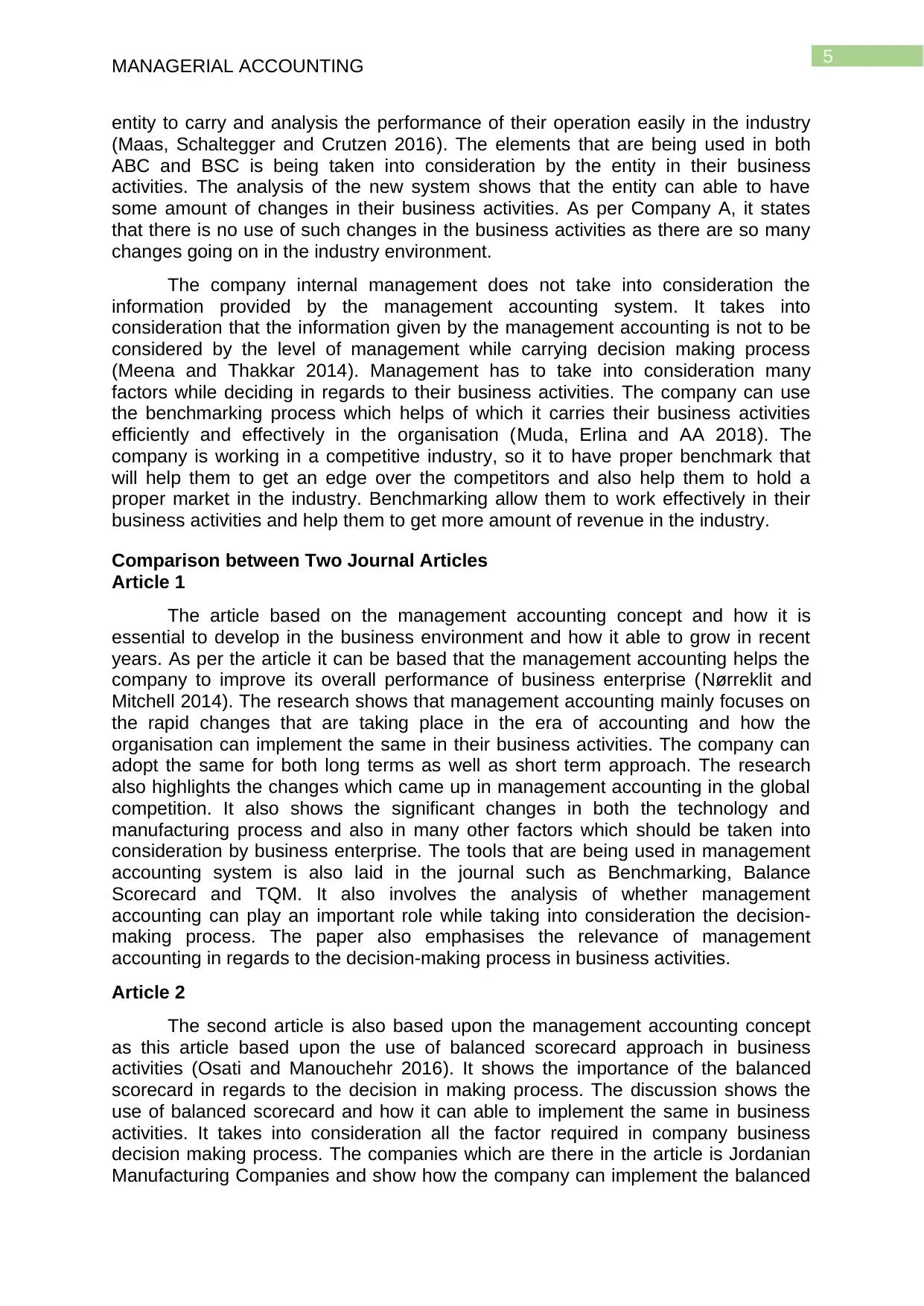
5
MANAGERIAL ACCOUNTING
entity to carry and analysis the performance of their operation easily in the industry
(Maas, Schaltegger and Crutzen 2016). The elements that are being used in both
ABC and BSC is being taken into consideration by the entity in their business
activities. The analysis of the new system shows that the entity can able to have
some amount of changes in their business activities. As per Company A, it states
that there is no use of such changes in the business activities as there are so many
changes going on in the industry environment.
The company internal management does not take into consideration the
information provided by the management accounting system. It takes into
consideration that the information given by the management accounting is not to be
considered by the level of management while carrying decision making process
(Meena and Thakkar 2014). Management has to take into consideration many
factors while deciding in regards to their business activities. The company can use
the benchmarking process which helps of which it carries their business activities
efficiently and effectively in the organisation (Muda, Erlina and AA 2018). The
company is working in a competitive industry, so it to have proper benchmark that
will help them to get an edge over the competitors and also help them to hold a
proper market in the industry. Benchmarking allow them to work effectively in their
business activities and help them to get more amount of revenue in the industry.
Comparison between Two Journal Articles
Article 1
The article based on the management accounting concept and how it is
essential to develop in the business environment and how it able to grow in recent
years. As per the article it can be based that the management accounting helps the
company to improve its overall performance of business enterprise (Nørreklit and
Mitchell 2014). The research shows that management accounting mainly focuses on
the rapid changes that are taking place in the era of accounting and how the
organisation can implement the same in their business activities. The company can
adopt the same for both long terms as well as short term approach. The research
also highlights the changes which came up in management accounting in the global
competition. It also shows the significant changes in both the technology and
manufacturing process and also in many other factors which should be taken into
consideration by business enterprise. The tools that are being used in management
accounting system is also laid in the journal such as Benchmarking, Balance
Scorecard and TQM. It also involves the analysis of whether management
accounting can play an important role while taking into consideration the decision-
making process. The paper also emphasises the relevance of management
accounting in regards to the decision-making process in business activities.
Article 2
The second article is also based upon the management accounting concept
as this article based upon the use of balanced scorecard approach in business
activities (Osati and Manouchehr 2016). It shows the importance of the balanced
scorecard in regards to the decision in making process. The discussion shows the
use of balanced scorecard and how it can able to implement the same in business
activities. It takes into consideration all the factor required in company business
decision making process. The companies which are there in the article is Jordanian
Manufacturing Companies and show how the company can implement the balanced
MANAGERIAL ACCOUNTING
entity to carry and analysis the performance of their operation easily in the industry
(Maas, Schaltegger and Crutzen 2016). The elements that are being used in both
ABC and BSC is being taken into consideration by the entity in their business
activities. The analysis of the new system shows that the entity can able to have
some amount of changes in their business activities. As per Company A, it states
that there is no use of such changes in the business activities as there are so many
changes going on in the industry environment.
The company internal management does not take into consideration the
information provided by the management accounting system. It takes into
consideration that the information given by the management accounting is not to be
considered by the level of management while carrying decision making process
(Meena and Thakkar 2014). Management has to take into consideration many
factors while deciding in regards to their business activities. The company can use
the benchmarking process which helps of which it carries their business activities
efficiently and effectively in the organisation (Muda, Erlina and AA 2018). The
company is working in a competitive industry, so it to have proper benchmark that
will help them to get an edge over the competitors and also help them to hold a
proper market in the industry. Benchmarking allow them to work effectively in their
business activities and help them to get more amount of revenue in the industry.
Comparison between Two Journal Articles
Article 1
The article based on the management accounting concept and how it is
essential to develop in the business environment and how it able to grow in recent
years. As per the article it can be based that the management accounting helps the
company to improve its overall performance of business enterprise (Nørreklit and
Mitchell 2014). The research shows that management accounting mainly focuses on
the rapid changes that are taking place in the era of accounting and how the
organisation can implement the same in their business activities. The company can
adopt the same for both long terms as well as short term approach. The research
also highlights the changes which came up in management accounting in the global
competition. It also shows the significant changes in both the technology and
manufacturing process and also in many other factors which should be taken into
consideration by business enterprise. The tools that are being used in management
accounting system is also laid in the journal such as Benchmarking, Balance
Scorecard and TQM. It also involves the analysis of whether management
accounting can play an important role while taking into consideration the decision-
making process. The paper also emphasises the relevance of management
accounting in regards to the decision-making process in business activities.
Article 2
The second article is also based upon the management accounting concept
as this article based upon the use of balanced scorecard approach in business
activities (Osati and Manouchehr 2016). It shows the importance of the balanced
scorecard in regards to the decision in making process. The discussion shows the
use of balanced scorecard and how it can able to implement the same in business
activities. It takes into consideration all the factor required in company business
decision making process. The companies which are there in the article is Jordanian
Manufacturing Companies and show how the company can implement the balanced
⊘ This is a preview!⊘
Do you want full access?
Subscribe today to unlock all pages.

Trusted by 1+ million students worldwide
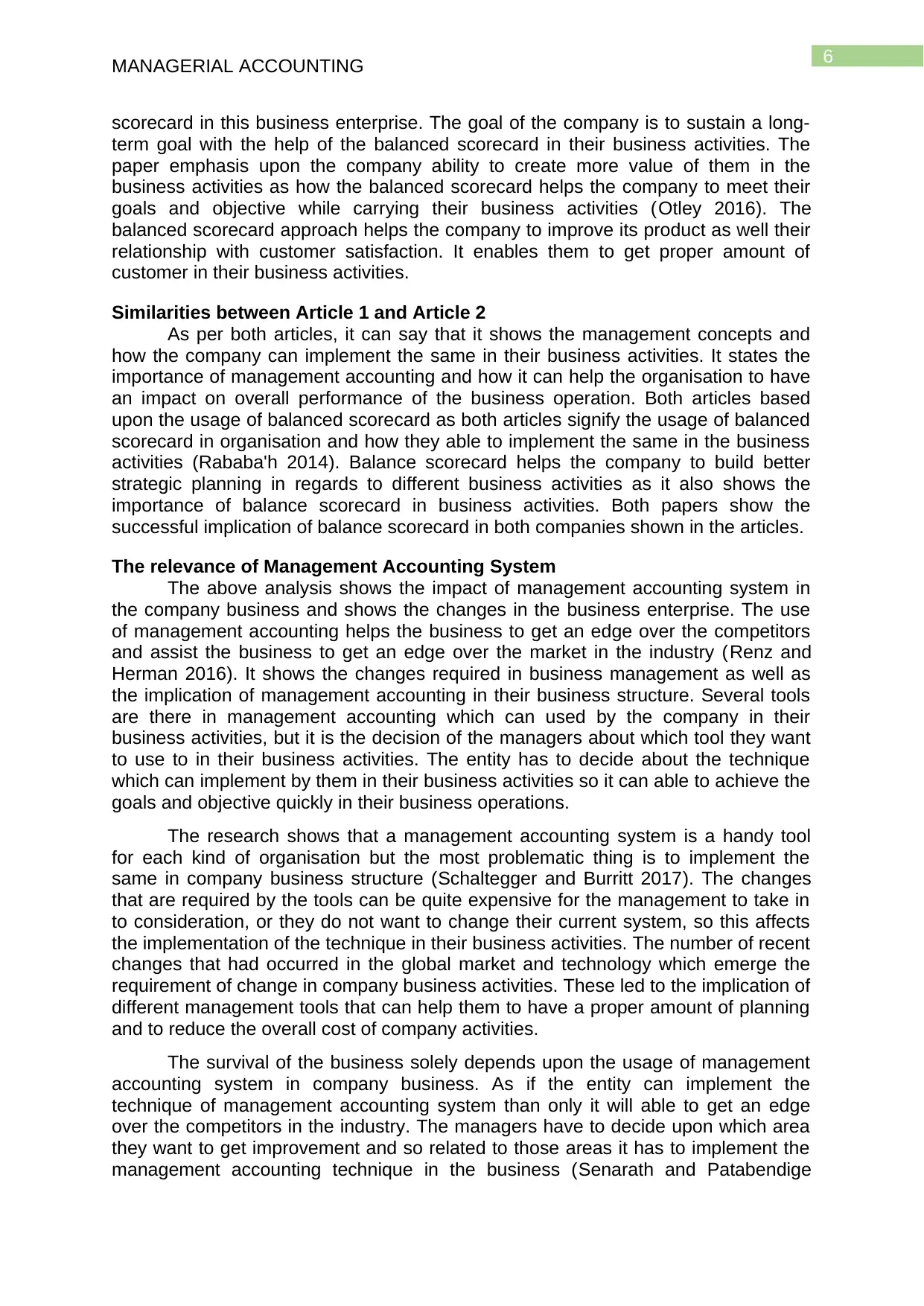
6
MANAGERIAL ACCOUNTING
scorecard in this business enterprise. The goal of the company is to sustain a long-
term goal with the help of the balanced scorecard in their business activities. The
paper emphasis upon the company ability to create more value of them in the
business activities as how the balanced scorecard helps the company to meet their
goals and objective while carrying their business activities (Otley 2016). The
balanced scorecard approach helps the company to improve its product as well their
relationship with customer satisfaction. It enables them to get proper amount of
customer in their business activities.
Similarities between Article 1 and Article 2
As per both articles, it can say that it shows the management concepts and
how the company can implement the same in their business activities. It states the
importance of management accounting and how it can help the organisation to have
an impact on overall performance of the business operation. Both articles based
upon the usage of balanced scorecard as both articles signify the usage of balanced
scorecard in organisation and how they able to implement the same in the business
activities (Rababa'h 2014). Balance scorecard helps the company to build better
strategic planning in regards to different business activities as it also shows the
importance of balance scorecard in business activities. Both papers show the
successful implication of balance scorecard in both companies shown in the articles.
The relevance of Management Accounting System
The above analysis shows the impact of management accounting system in
the company business and shows the changes in the business enterprise. The use
of management accounting helps the business to get an edge over the competitors
and assist the business to get an edge over the market in the industry (Renz and
Herman 2016). It shows the changes required in business management as well as
the implication of management accounting in their business structure. Several tools
are there in management accounting which can used by the company in their
business activities, but it is the decision of the managers about which tool they want
to use to in their business activities. The entity has to decide about the technique
which can implement by them in their business activities so it can able to achieve the
goals and objective quickly in their business operations.
The research shows that a management accounting system is a handy tool
for each kind of organisation but the most problematic thing is to implement the
same in company business structure (Schaltegger and Burritt 2017). The changes
that are required by the tools can be quite expensive for the management to take in
to consideration, or they do not want to change their current system, so this affects
the implementation of the technique in their business activities. The number of recent
changes that had occurred in the global market and technology which emerge the
requirement of change in company business activities. These led to the implication of
different management tools that can help them to have a proper amount of planning
and to reduce the overall cost of company activities.
The survival of the business solely depends upon the usage of management
accounting system in company business. As if the entity can implement the
technique of management accounting system than only it will able to get an edge
over the competitors in the industry. The managers have to decide upon which area
they want to get improvement and so related to those areas it has to implement the
management accounting technique in the business (Senarath and Patabendige
MANAGERIAL ACCOUNTING
scorecard in this business enterprise. The goal of the company is to sustain a long-
term goal with the help of the balanced scorecard in their business activities. The
paper emphasis upon the company ability to create more value of them in the
business activities as how the balanced scorecard helps the company to meet their
goals and objective while carrying their business activities (Otley 2016). The
balanced scorecard approach helps the company to improve its product as well their
relationship with customer satisfaction. It enables them to get proper amount of
customer in their business activities.
Similarities between Article 1 and Article 2
As per both articles, it can say that it shows the management concepts and
how the company can implement the same in their business activities. It states the
importance of management accounting and how it can help the organisation to have
an impact on overall performance of the business operation. Both articles based
upon the usage of balanced scorecard as both articles signify the usage of balanced
scorecard in organisation and how they able to implement the same in the business
activities (Rababa'h 2014). Balance scorecard helps the company to build better
strategic planning in regards to different business activities as it also shows the
importance of balance scorecard in business activities. Both papers show the
successful implication of balance scorecard in both companies shown in the articles.
The relevance of Management Accounting System
The above analysis shows the impact of management accounting system in
the company business and shows the changes in the business enterprise. The use
of management accounting helps the business to get an edge over the competitors
and assist the business to get an edge over the market in the industry (Renz and
Herman 2016). It shows the changes required in business management as well as
the implication of management accounting in their business structure. Several tools
are there in management accounting which can used by the company in their
business activities, but it is the decision of the managers about which tool they want
to use to in their business activities. The entity has to decide about the technique
which can implement by them in their business activities so it can able to achieve the
goals and objective quickly in their business operations.
The research shows that a management accounting system is a handy tool
for each kind of organisation but the most problematic thing is to implement the
same in company business structure (Schaltegger and Burritt 2017). The changes
that are required by the tools can be quite expensive for the management to take in
to consideration, or they do not want to change their current system, so this affects
the implementation of the technique in their business activities. The number of recent
changes that had occurred in the global market and technology which emerge the
requirement of change in company business activities. These led to the implication of
different management tools that can help them to have a proper amount of planning
and to reduce the overall cost of company activities.
The survival of the business solely depends upon the usage of management
accounting system in company business. As if the entity can implement the
technique of management accounting system than only it will able to get an edge
over the competitors in the industry. The managers have to decide upon which area
they want to get improvement and so related to those areas it has to implement the
management accounting technique in the business (Senarath and Patabendige
Paraphrase This Document
Need a fresh take? Get an instant paraphrase of this document with our AI Paraphraser
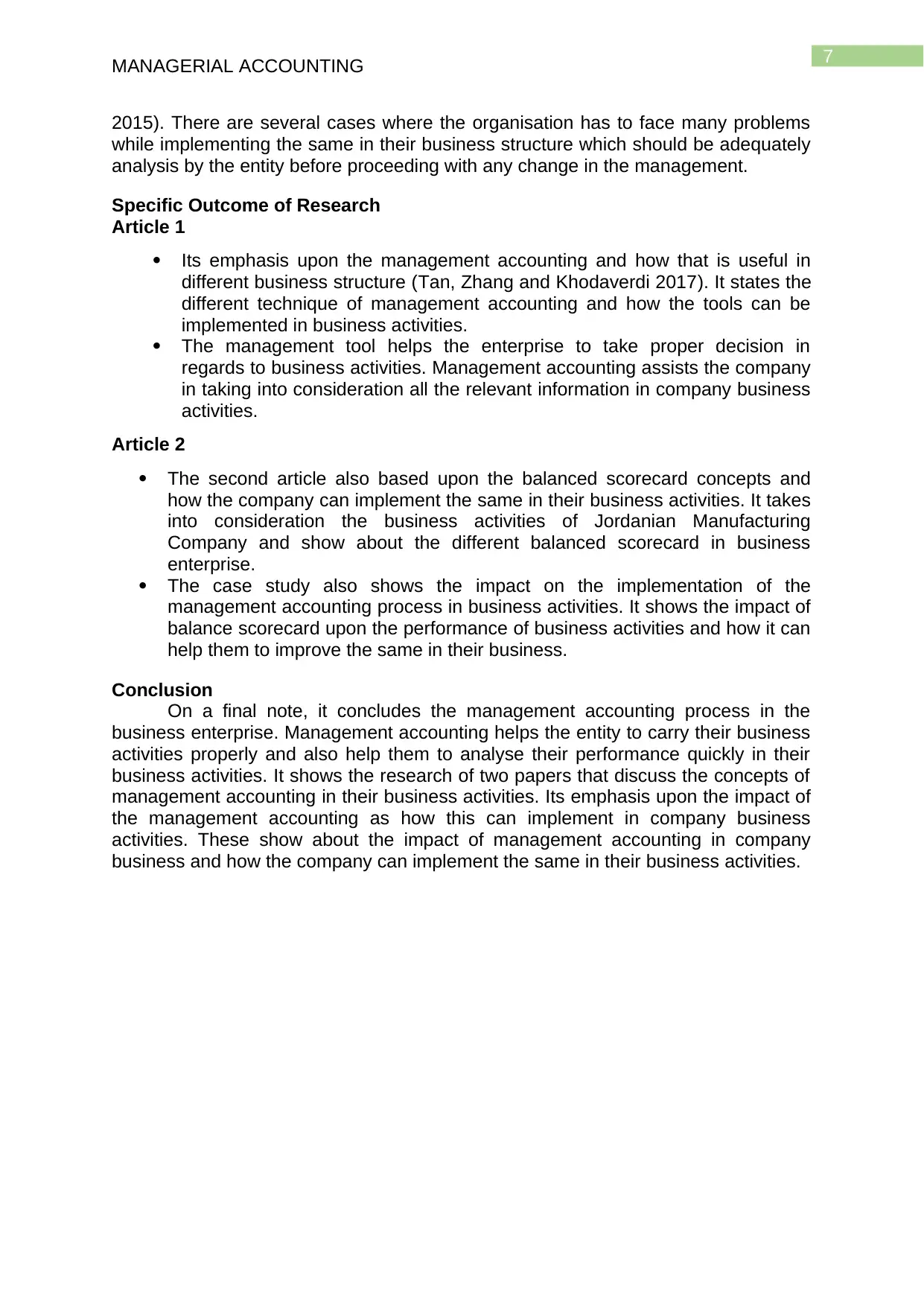
7
MANAGERIAL ACCOUNTING
2015). There are several cases where the organisation has to face many problems
while implementing the same in their business structure which should be adequately
analysis by the entity before proceeding with any change in the management.
Specific Outcome of Research
Article 1
Its emphasis upon the management accounting and how that is useful in
different business structure (Tan, Zhang and Khodaverdi 2017). It states the
different technique of management accounting and how the tools can be
implemented in business activities.
The management tool helps the enterprise to take proper decision in
regards to business activities. Management accounting assists the company
in taking into consideration all the relevant information in company business
activities.
Article 2
The second article also based upon the balanced scorecard concepts and
how the company can implement the same in their business activities. It takes
into consideration the business activities of Jordanian Manufacturing
Company and show about the different balanced scorecard in business
enterprise.
The case study also shows the impact on the implementation of the
management accounting process in business activities. It shows the impact of
balance scorecard upon the performance of business activities and how it can
help them to improve the same in their business.
Conclusion
On a final note, it concludes the management accounting process in the
business enterprise. Management accounting helps the entity to carry their business
activities properly and also help them to analyse their performance quickly in their
business activities. It shows the research of two papers that discuss the concepts of
management accounting in their business activities. Its emphasis upon the impact of
the management accounting as how this can implement in company business
activities. These show about the impact of management accounting in company
business and how the company can implement the same in their business activities.
MANAGERIAL ACCOUNTING
2015). There are several cases where the organisation has to face many problems
while implementing the same in their business structure which should be adequately
analysis by the entity before proceeding with any change in the management.
Specific Outcome of Research
Article 1
Its emphasis upon the management accounting and how that is useful in
different business structure (Tan, Zhang and Khodaverdi 2017). It states the
different technique of management accounting and how the tools can be
implemented in business activities.
The management tool helps the enterprise to take proper decision in
regards to business activities. Management accounting assists the company
in taking into consideration all the relevant information in company business
activities.
Article 2
The second article also based upon the balanced scorecard concepts and
how the company can implement the same in their business activities. It takes
into consideration the business activities of Jordanian Manufacturing
Company and show about the different balanced scorecard in business
enterprise.
The case study also shows the impact on the implementation of the
management accounting process in business activities. It shows the impact of
balance scorecard upon the performance of business activities and how it can
help them to improve the same in their business.
Conclusion
On a final note, it concludes the management accounting process in the
business enterprise. Management accounting helps the entity to carry their business
activities properly and also help them to analyse their performance quickly in their
business activities. It shows the research of two papers that discuss the concepts of
management accounting in their business activities. Its emphasis upon the impact of
the management accounting as how this can implement in company business
activities. These show about the impact of management accounting in company
business and how the company can implement the same in their business activities.
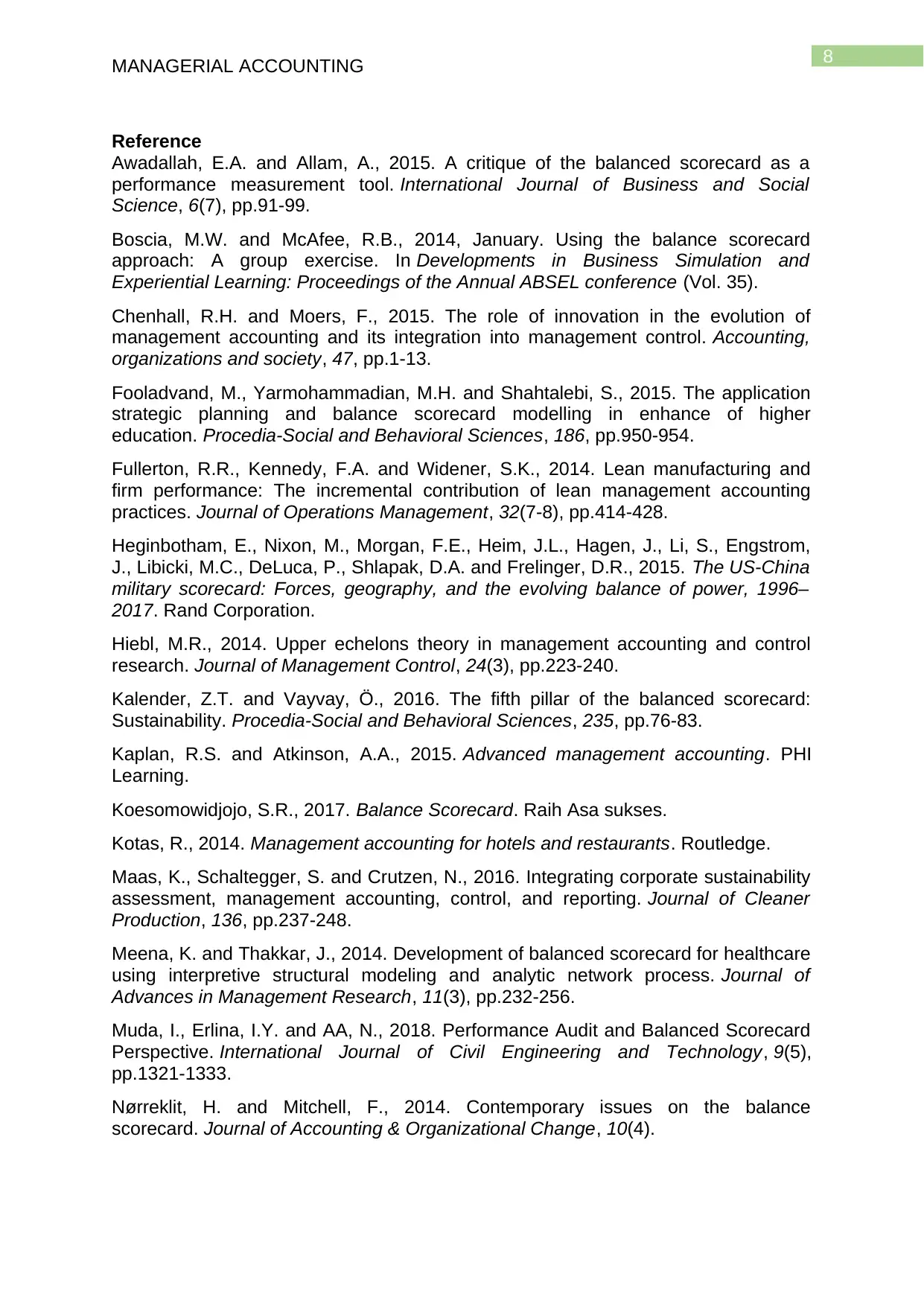
8
MANAGERIAL ACCOUNTING
Reference
Awadallah, E.A. and Allam, A., 2015. A critique of the balanced scorecard as a
performance measurement tool. International Journal of Business and Social
Science, 6(7), pp.91-99.
Boscia, M.W. and McAfee, R.B., 2014, January. Using the balance scorecard
approach: A group exercise. In Developments in Business Simulation and
Experiential Learning: Proceedings of the Annual ABSEL conference (Vol. 35).
Chenhall, R.H. and Moers, F., 2015. The role of innovation in the evolution of
management accounting and its integration into management control. Accounting,
organizations and society, 47, pp.1-13.
Fooladvand, M., Yarmohammadian, M.H. and Shahtalebi, S., 2015. The application
strategic planning and balance scorecard modelling in enhance of higher
education. Procedia-Social and Behavioral Sciences, 186, pp.950-954.
Fullerton, R.R., Kennedy, F.A. and Widener, S.K., 2014. Lean manufacturing and
firm performance: The incremental contribution of lean management accounting
practices. Journal of Operations Management, 32(7-8), pp.414-428.
Heginbotham, E., Nixon, M., Morgan, F.E., Heim, J.L., Hagen, J., Li, S., Engstrom,
J., Libicki, M.C., DeLuca, P., Shlapak, D.A. and Frelinger, D.R., 2015. The US-China
military scorecard: Forces, geography, and the evolving balance of power, 1996–
2017. Rand Corporation.
Hiebl, M.R., 2014. Upper echelons theory in management accounting and control
research. Journal of Management Control, 24(3), pp.223-240.
Kalender, Z.T. and Vayvay, Ö., 2016. The fifth pillar of the balanced scorecard:
Sustainability. Procedia-Social and Behavioral Sciences, 235, pp.76-83.
Kaplan, R.S. and Atkinson, A.A., 2015. Advanced management accounting. PHI
Learning.
Koesomowidjojo, S.R., 2017. Balance Scorecard. Raih Asa sukses.
Kotas, R., 2014. Management accounting for hotels and restaurants. Routledge.
Maas, K., Schaltegger, S. and Crutzen, N., 2016. Integrating corporate sustainability
assessment, management accounting, control, and reporting. Journal of Cleaner
Production, 136, pp.237-248.
Meena, K. and Thakkar, J., 2014. Development of balanced scorecard for healthcare
using interpretive structural modeling and analytic network process. Journal of
Advances in Management Research, 11(3), pp.232-256.
Muda, I., Erlina, I.Y. and AA, N., 2018. Performance Audit and Balanced Scorecard
Perspective. International Journal of Civil Engineering and Technology, 9(5),
pp.1321-1333.
Nørreklit, H. and Mitchell, F., 2014. Contemporary issues on the balance
scorecard. Journal of Accounting & Organizational Change, 10(4).
MANAGERIAL ACCOUNTING
Reference
Awadallah, E.A. and Allam, A., 2015. A critique of the balanced scorecard as a
performance measurement tool. International Journal of Business and Social
Science, 6(7), pp.91-99.
Boscia, M.W. and McAfee, R.B., 2014, January. Using the balance scorecard
approach: A group exercise. In Developments in Business Simulation and
Experiential Learning: Proceedings of the Annual ABSEL conference (Vol. 35).
Chenhall, R.H. and Moers, F., 2015. The role of innovation in the evolution of
management accounting and its integration into management control. Accounting,
organizations and society, 47, pp.1-13.
Fooladvand, M., Yarmohammadian, M.H. and Shahtalebi, S., 2015. The application
strategic planning and balance scorecard modelling in enhance of higher
education. Procedia-Social and Behavioral Sciences, 186, pp.950-954.
Fullerton, R.R., Kennedy, F.A. and Widener, S.K., 2014. Lean manufacturing and
firm performance: The incremental contribution of lean management accounting
practices. Journal of Operations Management, 32(7-8), pp.414-428.
Heginbotham, E., Nixon, M., Morgan, F.E., Heim, J.L., Hagen, J., Li, S., Engstrom,
J., Libicki, M.C., DeLuca, P., Shlapak, D.A. and Frelinger, D.R., 2015. The US-China
military scorecard: Forces, geography, and the evolving balance of power, 1996–
2017. Rand Corporation.
Hiebl, M.R., 2014. Upper echelons theory in management accounting and control
research. Journal of Management Control, 24(3), pp.223-240.
Kalender, Z.T. and Vayvay, Ö., 2016. The fifth pillar of the balanced scorecard:
Sustainability. Procedia-Social and Behavioral Sciences, 235, pp.76-83.
Kaplan, R.S. and Atkinson, A.A., 2015. Advanced management accounting. PHI
Learning.
Koesomowidjojo, S.R., 2017. Balance Scorecard. Raih Asa sukses.
Kotas, R., 2014. Management accounting for hotels and restaurants. Routledge.
Maas, K., Schaltegger, S. and Crutzen, N., 2016. Integrating corporate sustainability
assessment, management accounting, control, and reporting. Journal of Cleaner
Production, 136, pp.237-248.
Meena, K. and Thakkar, J., 2014. Development of balanced scorecard for healthcare
using interpretive structural modeling and analytic network process. Journal of
Advances in Management Research, 11(3), pp.232-256.
Muda, I., Erlina, I.Y. and AA, N., 2018. Performance Audit and Balanced Scorecard
Perspective. International Journal of Civil Engineering and Technology, 9(5),
pp.1321-1333.
Nørreklit, H. and Mitchell, F., 2014. Contemporary issues on the balance
scorecard. Journal of Accounting & Organizational Change, 10(4).
⊘ This is a preview!⊘
Do you want full access?
Subscribe today to unlock all pages.

Trusted by 1+ million students worldwide
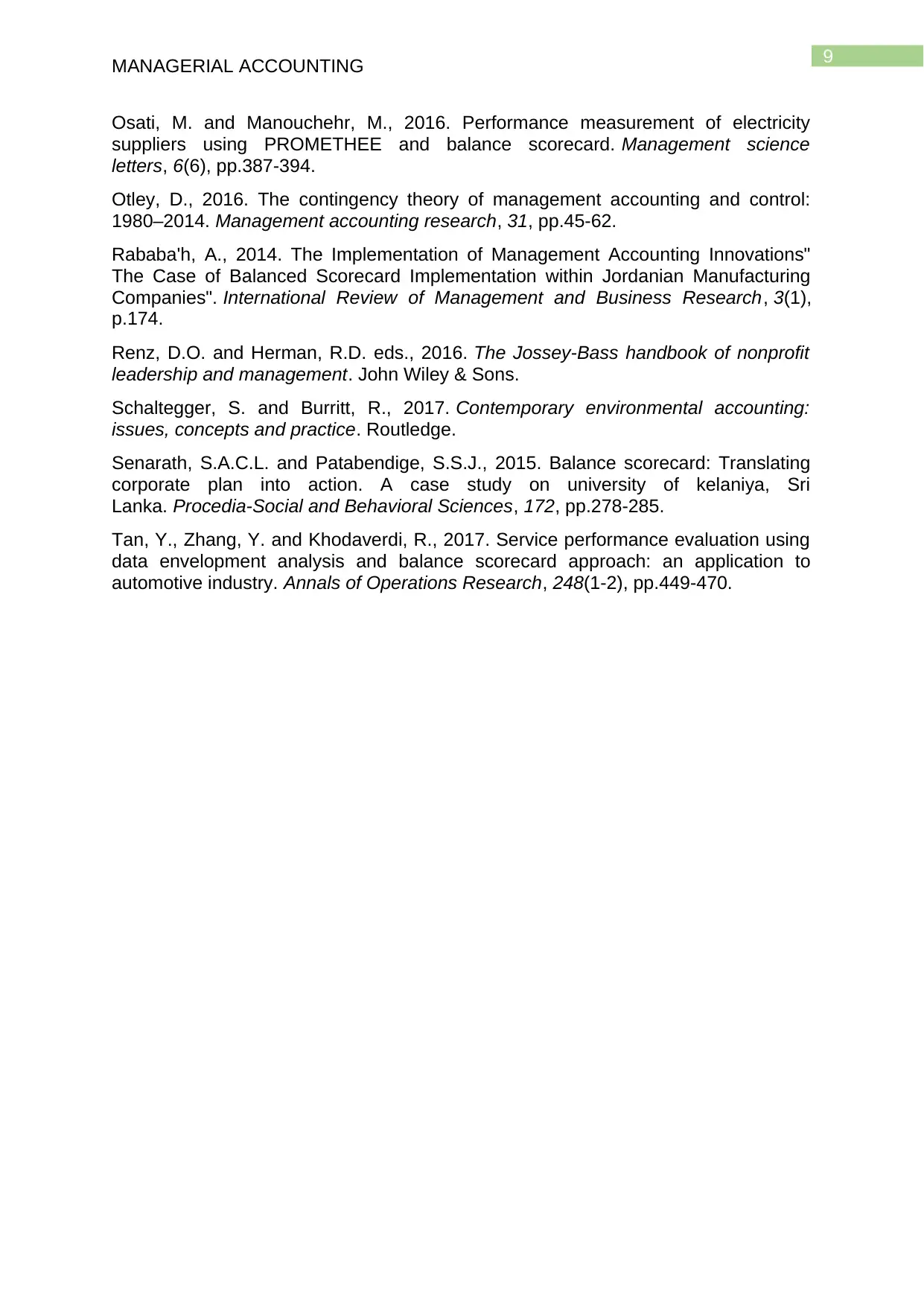
9
MANAGERIAL ACCOUNTING
Osati, M. and Manouchehr, M., 2016. Performance measurement of electricity
suppliers using PROMETHEE and balance scorecard. Management science
letters, 6(6), pp.387-394.
Otley, D., 2016. The contingency theory of management accounting and control:
1980–2014. Management accounting research, 31, pp.45-62.
Rababa'h, A., 2014. The Implementation of Management Accounting Innovations"
The Case of Balanced Scorecard Implementation within Jordanian Manufacturing
Companies". International Review of Management and Business Research, 3(1),
p.174.
Renz, D.O. and Herman, R.D. eds., 2016. The Jossey-Bass handbook of nonprofit
leadership and management. John Wiley & Sons.
Schaltegger, S. and Burritt, R., 2017. Contemporary environmental accounting:
issues, concepts and practice. Routledge.
Senarath, S.A.C.L. and Patabendige, S.S.J., 2015. Balance scorecard: Translating
corporate plan into action. A case study on university of kelaniya, Sri
Lanka. Procedia-Social and Behavioral Sciences, 172, pp.278-285.
Tan, Y., Zhang, Y. and Khodaverdi, R., 2017. Service performance evaluation using
data envelopment analysis and balance scorecard approach: an application to
automotive industry. Annals of Operations Research, 248(1-2), pp.449-470.
MANAGERIAL ACCOUNTING
Osati, M. and Manouchehr, M., 2016. Performance measurement of electricity
suppliers using PROMETHEE and balance scorecard. Management science
letters, 6(6), pp.387-394.
Otley, D., 2016. The contingency theory of management accounting and control:
1980–2014. Management accounting research, 31, pp.45-62.
Rababa'h, A., 2014. The Implementation of Management Accounting Innovations"
The Case of Balanced Scorecard Implementation within Jordanian Manufacturing
Companies". International Review of Management and Business Research, 3(1),
p.174.
Renz, D.O. and Herman, R.D. eds., 2016. The Jossey-Bass handbook of nonprofit
leadership and management. John Wiley & Sons.
Schaltegger, S. and Burritt, R., 2017. Contemporary environmental accounting:
issues, concepts and practice. Routledge.
Senarath, S.A.C.L. and Patabendige, S.S.J., 2015. Balance scorecard: Translating
corporate plan into action. A case study on university of kelaniya, Sri
Lanka. Procedia-Social and Behavioral Sciences, 172, pp.278-285.
Tan, Y., Zhang, Y. and Khodaverdi, R., 2017. Service performance evaluation using
data envelopment analysis and balance scorecard approach: an application to
automotive industry. Annals of Operations Research, 248(1-2), pp.449-470.
1 out of 10
Related Documents
Your All-in-One AI-Powered Toolkit for Academic Success.
+13062052269
info@desklib.com
Available 24*7 on WhatsApp / Email
![[object Object]](/_next/static/media/star-bottom.7253800d.svg)
Unlock your academic potential
Copyright © 2020–2025 A2Z Services. All Rights Reserved. Developed and managed by ZUCOL.



